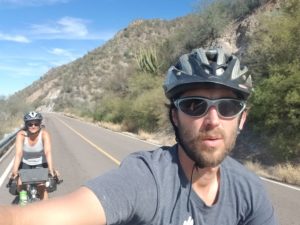
BY PHIL CUSTODIO
Clarkston News Editor
Clarkston grad Chris Haag’s hemisphere-crossing bike trip is into its third country, with him and his wife Sophie George peddling into Mexico last month.
“Going across the border was relatively uneventful besides the fact that we didn’t have any Pesos on us and Mexican border patrol only takes cash,” Haag said. “The woman actually stamped our passports, let us into the country, directed us to the closest ATM and said, ‘Please come back and pay.’ We, of course, did.”
They left Bisbee, Ariz., on Nov. 29, and crossed at a little town called Naco. The first day was brutal, with winds close to 20 mph, Haag said.
“We rode about 50 miles into Mexico and got the first hotel we could find. It was in a strange business park with fancy restaurants that sort of reminded me of Somerset Mall. The town was called Cananea,” he said.
“The next day we got onto Highway 89, which is one of the most beautiful stretches of road we have been on in the entire trip. It is very hilly and constantly twisting. I don’t think there is a flat section to it. The next couple hundred miles were like that.”
Terrain was desert with mountains and plateaus all around, surprisingly green compared to Arizona.
“There were lots of farms and orchards and little oases along the Sonora River Valley,” he said. “The road is set up perfectly for cycle touring. You come across a town every 30 to 50 miles. They’re all very quiet and set in the mountains and you can get a hotel for $20 and a great dinner for $5.”
One night they again were without cash with no ATM in town. Somebody offered to pay for their room and another person bought them dinner.
From there they rode into the capital of the Sonora state, Hermosillo.
“It is a relatively large and modern city. We spent a few days there with some hosts we met through a site called WarmShowers.org, which connects cycle tourists with people willing to put them up for a night or two, use the shower, and do laundry,” he said. “It is a beautiful city. Most towns here have a plaza in the center of them that public life tends to center around. There is usually a fountain or beautiful gazebo and there are always hundreds of people walking around or sitting under trees.”
From Hermosillo, they cycled to the Sea of Cortez.
“We hadn’t been near the ocean since Oregon, and the water was cold there. Bahia Kino was a great little beach town where we camped for two nights,” Haag said. “From there we went to El Colorado, which is a very quiet fishing town that really doesn’t have any tourism. We found a secluded beach and stayed there for two days.”
San Carlos is a bit of an ex-pat town. “We tend to avoid these places as they are a bit more hectic and expensive, but we trying to figure out some logistics to get to Baja,” he said. “The winds have been too strong for the ferry here, so we may ride down into the state of Sinaloa and go to Copper Canyon, which is one of the most beautiful train rides in the world. From there we would find a different boat to Baja.”
Haag, whose home is in Utah, graduated from Clarkston High School in 2001. He also tended bar at the Clarkston Union for several years before working for a local energy conservation company.
He and his wife are in the midst of a two-year bicycle trip from Alaska to Argentina to promote cycling as a sustainable means of transportation and travel.
Keep up on their adventure by visiting their blog at www.ThePlacesipee.com.
